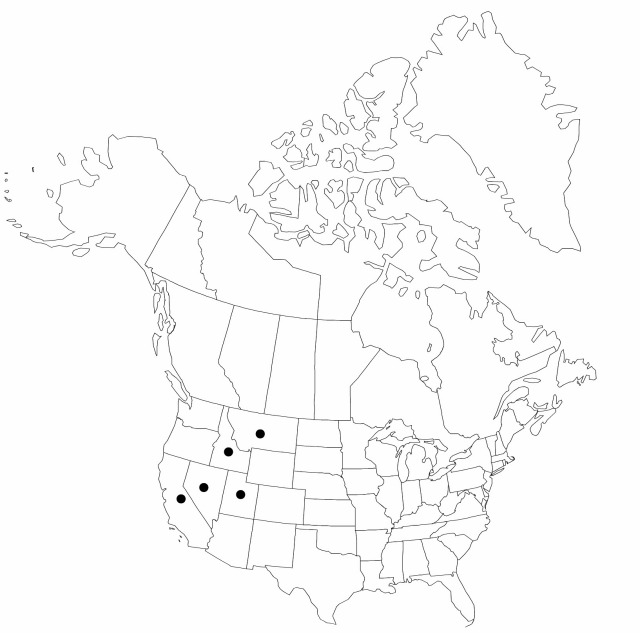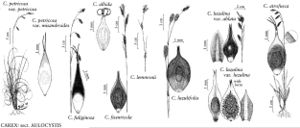Carex fissuricola
Muhlenbergia 5: 53. 1909.
Plants densely or loosely cespitose; rhizomes thick, short. Culms to 80 cm. Leaves: blades 3–8 mm wide. Inflorescences with 3–5 spikes; peduncles of proximal spikes exserted more than 1 cm; proximal bracts with blade (10–) 15–50 mm, sheaths cylindric to ± expanded to mouth, 20–37 mm, mouth with narrow, ± purple band at top, usually Y or V-shaped, mouth 0.7–1.8 mm wide. Lateral spikes pistillate or often androgynous, purple to brown, proximal spikes pendent to erect, 14–25 × 4–7 mm. Terminal spike staminate or androgynous, ± erect, 10–21 × 4.5–6 mm. Pistillate scales purple or brown with pale, usually indistinctly veined, ovate to elliptic, 2.3–3.8 × 0.8–1.7 mm, midvein and margins ciliate, apex obtuse to short-awned. Staminate scales purple or reddish-brown with pale midvein, ovate to obovate, 3–4.4 × 1–1.4 mm, margins slightly ciliate, apex obtuse. Anthers 1.5–3 mm. Perigynia ascending, usually purple or redbrown, veins usually indistinct, ovate to elliptic, 3.2–5.5 × 0.9–1.7 (–2) mm, margins flat, less than 1/2 mature achene width, margins setose-ciliate distally, usually at least sparsely hispidulous to shortly setose; beak ± distinct, apex brown to purple, setose-ciliate, distance from beak tip to achene apex usually more than 2 mm. Achenes obovoid, body 1.5–2 × 0.8–1 mm.
Phenology: Fruiting summer.
Habitat: Meadows, rocky stream banks
Elevation: 1500–3500 m
Distribution

Calif., Idaho, Mont., Nev., Utah.
Discussion
Carex fissuricola is intermediate between C. luzulifolia and C. luzulina. A population in Lemhi County, Idaho, has the terminal spike gynecandrous and the perigynium glabrous or subglabrous. It is tentatively included in C. fissuricola.
Selected References
None.
Lower Taxa
"shortened" is not a number."thick" is not a number.
